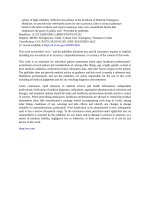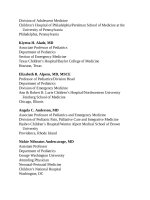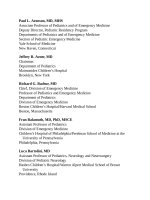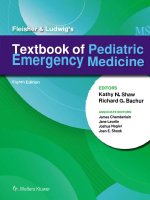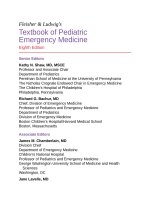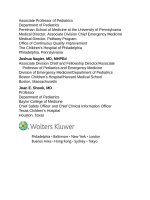Pediatric emergency medicine trisk 0646 0646
Bạn đang xem bản rút gọn của tài liệu. Xem và tải ngay bản đầy đủ của tài liệu tại đây (105.3 KB, 1 trang )
meningitis in infancy. A febrile infant who does not appropriately respond to
painful procedures (e.g., venipuncture) may have sepsis due to serious infection.
Importantly, neither clinical scores, such as the Yale Observation Score, nor
unstructured clinician suspicion reliably identifies very young infants with serious
bacterial infections. Appropriate laboratory testing should therefore be pursued in
the febrile young infant younger than 60 days.
Other signs of severe or life-threatening infections heralded by fever should be
sought early in the examination. CNS infections may be marked by fever with
altered sensorium, convulsion, meningismus, or focal neurologic deficits.
However, infants younger than 2 months of age with meningitis may not have
meningismus. They may instead have irritability, somnolence, a bulging fontanel,
or nonspecific symptoms such as anorexia, lethargy, or vomiting. Severe upper
airway infections may present with stridor, excessive drooling, and tripod
positioning. A child with pneumonia, pericarditis, endocarditis, or sepsis
syndrome may display tachycardia, dyspnea or tachypnea, cyanosis or pallor,
poor perfusion or hypotension, as well as altered mental status. Hemorrhagic
rashes may signal bacterial or rickettsial infections such as meningococcemia or
Rocky Mountain spotted fever.
Careful assessment of the vital signs can provide early important clues to more
severe illnesses. Severe sepsis and septic shock are defined as infections with
organ dysfunction (see Chapter 10 Shock ). It is important to note, however, that
hypotension is a late finding in children, and that prompt recognition of the child
with compensated septic shock is critical in the ED. That said, recognition of
compensated shock can be quite challenging in children, as the prevalence of
systemic inflammatory response syndrome (SIRS) defined by fever, tachycardia,
and tachypnea is high in pediatric patients, the majority of whom are not critically
ill. However, close observation of children with fever and tachycardia is
warranted. If the tachycardia resolves with antipyretics and/or oral hydration, and
the child is well appearing with normal perfusion and mental status, the child
should undergo an evaluation based on the algorithm in Figure 31.1 . If
tachycardia persists, the child is ill appearing, has a high-risk condition, poor
perfusion, or altered mental status, more aggressive treatment for sepsis may be
indicated including rapid fluid resuscitation and antimicrobial therapy. Formal
sepsis bundles to increase recognition and decrease time to treatment have been
shown to lower in-hospital mortality among children with sepsis and septic shock.
Although the index of suspicion for serious febrile illness must be high
throughout the evaluation of each child, most childhood illnesses with fever are
minor and self-limiting. Once the physician has ascertained that the child is not in
